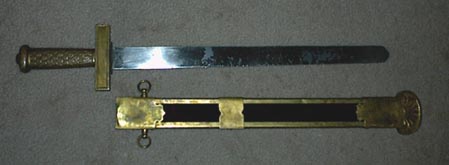Gladius Style,
or "Artillery-Style"
Short-Sword

The following sword is yet another one that I cannot
positively identify. It appears to be a costume, fraternal
or society sword - in the French Ecole de Mars
Revolutionary Military Academy, c.1794/5 style - but this
example most likely dates from the period of about 1900 to
1950 (possibly later).
The hilt crossguard, ferrule, and pommel are all integrated
and of cast brass.The style is very similar to the
neo-classical Roman Gladius Short-Sword. The grip has
12 rows of "fish-scales" or "feathers." The cross-guard is
devoid of proper quillon finials, and crossguard ends in 90
degree angles. Hilt is attached to the blade by method of
peening and deforming the blade tang.
The blade is 17-3/4" long; blade cross-section is flat
rectangular ~ 1/8" in thickness, ~1-3/8 in height. The blade
is un-fullered; doubled-edged but edges are flat, not
sharpened. The sword is obviously intended for a
non-combatant - blade-point is blunted - and would not be
useful as a cutting or thrusting weapon. Blade is unmarked,
so maker is not immediately apparent.
The scabbard is 19-1/8" long, including drag. It is
sheet-steel, brass-plated, with red-velvet vertical
center-cloth (color indicates rank); the drag is of brass
and is retained by two side-screws, near the top; throat is
unremarkable with the exception of the two hanger ringlets.
Further thoughts -
I am sure this is for ceremonial or
costume use only and I was told this sword came from an
Independent Order of Odd Fellows (IOOF) lodge (not a Masonic
order).
A comparable sword is listed in the Ames Sword Company catalog of the late 1800's as item number 339 under I.O.O.F. [Independent Order of Odd Fellows] - Short Swords, "Roman Sword, square edged, Velvet Scabbard."
